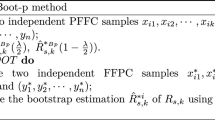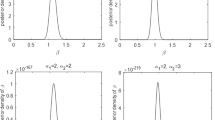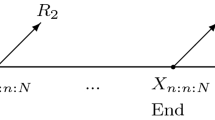Abstract
This paper considers the problem of making inference for a multicomponent stress–strength (MSS) model under Type-II censoring. It is assumed that stress–strength components of the multicomponent system follow unit generalized Rayleigh (UGR) distributions. Inferences are derived when the strength and stress have a common unknown UGR parameters. We derive maximum likelihood estimator of MSS reliability based on observed censored data. In sequel, interval estimator is evaluated using delta method and asymptotic normality property. Pivotal quantities based inference upon MSS reliability are derived as well. In addition, we further consider the case when all the parameters of stress–strength model are unknown and obtain various inferences for the reliability. Equivalence of model parameters is considered based on likelihood ratio test. Assessment of different methods is evaluated from Monte Carlo simulations and remarks are presented for further discussion. Three numerical examples including a petroleum reservoirs data are analyzed for illustration purposes.










Similar content being viewed by others
Data availability
Data available on request.
References
Ahmad K, Fakhry M, Jaheen Z (1997) Empirical Bayes estimation of p(Y < X) and characterizations of burr-type x model. J Stat Plan Inference 64:297–308
Akaike H (1974) A new look at the statistical model identifications. IEEE Trans Autom Control 19:716–723
Balakrishnan, N, Cramer, E (2014). The art of progressive censoring. In: Statistics for industry and technology. Birkhauser New York
Bhattacharyya G (1985) The asymptotic of maximum likelihood and related estimators based on Type II censored data. J Am Stat Assoc 80:398–404
Bhattacharyya G, Johnson RA (1974) Estimation of reliability in a multicomponent stress-strength model. J Am Stat Assoc 69:966–970
Birnbaum Z, McCarty R (1958) A distribution-free upper confidence bound for p(Y < X) based on independent samples of X and Y. Ann Math Stat 29(2):558–562
Birnbaum ZW (1956, January). On a use of the Mann-Whitney statistic. In: Proceedings of the Third Berkeley Symposium on Mathematical Statistics and Probability, Volume 1: Contributions to the Theory of Statistics. University of California Press. 3: 13–18.
Casella G, Berger RL (2002) Statistical inference, volume 2. Duxbury Pacific Grove, CA
Constantine K, Tse SK, Karson M (1986) Estimation of p(y < x) in the gamma case. Commun Stat-Simul Comput 15:365–388
Cox DR (1961) Tests of separate families of hypotheses. In: Proceedings of the Fourth Berkeley Symposium in Mathematical Statistics and Probability. University of California Press, Berkeley
Cook DO, Kieschnick R, McCullough BD (2008) Regression analysis of proportions in finance with self selection. J Empir Financ 15(5):860–867
Dey S, Moala FA (2019) Estimation of reliability of multicomponent stress -strength of a bathtub shape or increasing failure rate function. Int J Qual Reliab Manag 36(2):122–136
Dey S, Mazucheli J, Anis M (2017) Estimation of reliability of multicomponent stress-strength for a Kumaraswamy distribution. Commun Stat-Theory Methods 46:1560–1572
Gao S, Yu J, Gui W (2020) Pivotal inference for the inverted exponentiated Rayleigh distribution based on progressive type-ii censored data. Am J Math Manag Sci 39(4):315–328
Gómez-Déniz E, Sordo MA, Calderín-Ojeda E (2014) The Log-Lindley distribution as an alternative to the beta regression model with applications in insurance. Insur Math Econ 54:49–57
Grassia A (1977) On a family of distributions with argument between 0 and 1 obtained by transformation of the gamma and derived compound distributions. Austral J Stat 19:108–114
Gunasekera S (2015) Generalized inferences of p(Y < X) for pareto distribution. Stat Pap 56:333–351
Jha MK, Dey S, Tripathi YM (2019) Reliability estimation in a multicomponent stress-strength based on unit-Gompertz distribution. Int J Qual Reliab Manag 37(3):428–450
Jha MK, Dey S, Alotaibi RM, Tripathi YM (2020) Reliability estimation of a multicomponent stress-strength model for unit Gompertz distribution under progressive type ii censoring. Qual Reliab Eng Int 36:965–987
Jia J, Yan Z, Song H, Chen Y (2023) Reliability estimation in multicomponent stress–strength model for generalized inverted exponential distribution. Soft Comput 27(2):903–916
Kayal T, Tripathi YM, Dey S, Wu SJ (2020) On estimating the reliability in a multi-component stress-strength model based on chen distribution. Commun Stat-Theory Methods 49:2429–2447
Khakifirooz M (2020) Model misspecification of generalized gamma distribution for accelerated lifetime-censored data. Technometrics 62(3):1–6
Kizilaslan F (2017) Classical and bayesian estimation of reliability in a multicomponent stress-strength model based on the proportional reversed hazard rate mode. Math Comput Simul 136:36–42
Kizilaslan F (2018) Classical and Bayesian estimation of reliability in a multi-component stress-strength model based on a general class of inverse exponentiated distributions. Stat Pap 59:1161–1192
Kizilaslan F, Nadar M (2015) Classical and Bayesian estimation of reliability inmulticomponent stress-strength model based on Weibull distribution. Revista Colombiana De Estadstica 38:467–484
Kohansal A, Shoaee S (2021) Bayesian and classical estimation of reliability in a multicomponent stress-strength model under adaptive hybrid progressive censored data. Stat Pap 62(1):309–359
Kotz S, Pensky M (2003) The stress-strength model and its generalizations: theory and applications. World Scientific
Kundu D, Gupta RD (2005) Estimation of p(Y < X) for generalized exponential distribution. Metrika 61:291–308
Lawless JF (2003) Statistical models and methods for lifetime data. Wiley, New York
Marcel Dekker, New York. Team RC (2017) R core team. R: A language and environment for statistical computing, R Found. Stat. Comput. Vienna, Austria. URL http://www.R-project. Accessed 1 Mar 2023
Mazucheli J, Menezes AF, Dey S (2019) Unit-gompertz distribution with applications. Statistica (bologna) 79:25–33
Nadar M, Kiziaslan F (2015) Estimation of reliability in a multicomponent stress-strength model based on a Marshall-Olkin bivariate Weibull distribution. IEEE Trans Reliab 65:370–380
Papke LE, Wooldridge JM (1996) Econometric methods for fractional response variables with an application to 401 (k) plan participation rates. J Appl Economet 11(6):619–632
Pascual FG (2005) Maximum likelihood estimation under misspecified log-normal and Weibull distributions. Commun Stat-Simul Comput 34:503–524
Rao GS, Aslam M, Kundu D (2015) Burr-xii distribution parametric estimation and estimation of reliability of multi-component stress-strength. Commun Stat-Theory Methods 44:4953–4961
Schwarz G (1978) Estimating the dimension of a model. Ann Stat 6:461–464
Seo JI, Kang SB (2015) Pivotal inference for the scaled half logistic distribution based on progressively type-ii censored samples. Statist Probab Lett 104:109–116
Singh K, Mahto AK, Tripathi YM, Wang L (2023) Estimation in a multicomponent stress-strength model for progressive censored lognormal distribution. Proc Inst Mech Eng Part O J Risk Reliab. https://doi.org/10.1177/1748006X231156841
Singh K, Mahto AK, Tripathi YM, Wang L (2024) Inference for reliability in a multicomponent stress-strength model for a unit inverse Weibull distribution under type-II censoring. Qual Technol Quant Manag 21(2): 147–176
Stephens M (1986) Tests for the exponential distribution. In Goodness-of-Fit Techniques. Eds. R.B. D'Agostinho, M.A. Stephens, pp 421-459, Marcel Dekker New York
Viveros R, Balakrishnan N (1994) Interval estimation of parameters of life from progressively censored data. Technometrics 36:84–91
Wang L, Dey S, Tripathi YM, Wu SJ (2020) Reliability inference for a multicomponent stress-strength model based on Kumaraswamy distribution. J Comput Appl Math 376:112823
Wang L, Wu K, Tripathi YM, Lodhi C (2022) Reliability analysis of multicomponent stress–strength reliability from a bathtub-shaped distribution. J Appl Stat 49(1):122–142
Weerahandi S (2004) Generalized inference in repeated measures: exact methods in MANOVA and mixed models, vol 500. Wiley, New York
Xavier T, Jose JK (2020) A study of stress-strength reliability using a generalization of power transformed half-logistic distribution. Commun Stat-Theory Methods 50(18):4335–4351
Xu J, Long JS (2005) Using the delta method to construct confidence intervals for predicted probabilities, rates, and discrete changes. In: Lecture Notes, Indiana University
Acknowledgements
The authors would like to thank the editor and the referees for their insightful comments that have led to a substantial improvement to an earlier version of the paper.
Funding
This work of Liang Wang was supported by the National Natural Science Foundation of China (No. 12061091), the Yunnan Fundamental Research Projects (No. 202101AT070103) Yunnan Key Laboratory of Modern Analytical Mathematics and Applications. The research work of Yogesh Mani Tripathi is partially financially supported under a grant MTR/2022/000183 by Science and Engineering Research Board, India.
Author information
Authors and Affiliations
Corresponding author
Ethics declarations
Conflict of interest
Authors do not have any financial relationship with an organization that sponsored the research and did not receive any compensation or consultancy work. There are not any potential conflicts of interests that are directly or indirectly related to the research.
Ethical approval
This article does not contain any studies with human participants or animals performed by any of the authors.
Informed consent The manuscript is approved by all authors for publication.
Additional information
Publisher's Note
Springer Nature remains neutral with regard to jurisdictional claims in published maps and institutional affiliations.
Appendices
A. Proof of Theorem 2
We recall that \({{{R}}}_{{{s}},{{k}}}\) is expressed as \({{{R}}}_{{{s}},{{k}}}\left(\upgamma \right)\) as defined in (6). Also using Taylor’s theorem, \({{{R}}}_{{{s}},{{k}}}\left(\widehat{\upgamma }\right)\) written as (e.g., Xu and Long (2005))
where \(\nabla {{{R}}}_{{{s}},{{k}}}\left(\upgamma \right)\) and \({\nabla }^{2}{{{R}}}_{{{s}},{{k}}}\left({\upgamma }^{*}\right)\) denote respective matrices. Note also \({\upgamma }^{*}\) lies between \(\upgamma \) and \(\widehat{\upgamma }\). Then expression (25) turns out to be \({{{R}}}_{{{s}},{{k}}}\left(\widehat{\upgamma }\right)\to {{{R}}}_{{{s}},{{k}}}\left(\upgamma \right)\) as \({{n}}\to \infty \) as Theorem 1 implies that \(\widehat{\upgamma }\to\upgamma \).
The variance of \({{{R}}}_{{{s}},{{k}}}\left(\widehat{\upgamma }\right)\) is given by
Therefore, we further get that
This completes the proof.
Proof of Theorem 3
Given \({{i}}={1,2},\ldots,{{m}}\), let \({Z}_{i1},{Z}_{i2},\ldots,{Z}_{is}\) be order statistics from UGR distribution. So \({R}_{s,k}\left(\widehat{\eta }\right)-{{{R}}}_{{{s}},{{k}}}\left(\upeta \right)\approx {\left[\nabla {{{R}}}_{{{s}},{{k}}}\left(\upeta \right)\right]}^{{{T}}}{X}_{ij}=-{\vartheta }_{1}{{log}}\left(1-{B}_{ij}\right),j={1,2},\cdots s\) denote censored samples from standard exponential distribution. We have.
Are independent and identically distributed as standard exponential distribution (see, e.g., Lawless (2003)).
Consider \({W}_{ij}=\sum_{r=1}^{j}{L}_{ir}={-\vartheta }_{1}\left\{\sum_{r=1}^{j}{{log}}\left(1-{B}_{ir}\right)+\left(k-j\right){{log}}\left(1-{B}_{ij}\right)\right\},\)
\(j={1,2},\ldots,\) s, and using Stephens (1986) and Viveros and Balakrishnan (1994), one further has that the quantities
denote order statistics from \({{U}}\left({0,1}\right)\) distribution. Also \({U}_{i1}<{U}_{i2}<\cdots {U}_{i\left(s-1\right)}\) being independent with \({W}_{is}{=-\vartheta }_{1}\left[\sum_{r=1}^{s}{{log}}\left(1-{B}_{ir}\right)+\left[k-s\right]{{log}}\left(1-{B}_{is}\right)\right]\).
We have
is chi-square distributed with \(2\left({{s}}-1\right)\) degrees of freedom and is independent of
is \({\chi }^{2}\left(2s\right)\) random variable.
Thus from independence of \({D}_{i1}\left(\varepsilon \right),{D}_{i2}\left(\varepsilon \right),\ldots,{D}_{im}\left(\varepsilon \right)\), it is seen that
is a \(\chi^{2} \left( {2m\left( {s - 1} \right)} \right)\) variable
follows \({\chi }^{2}\left(2ms\right)\) distribution, and \({D}_{1}^{Z}\left(\varepsilon \right)\) and \({E}_{1}^{Z}\left({\vartheta }_{1},\varepsilon \right)\) are statistical independent. Thus proof is completed.
Proof of Lemma 1
From the definition of \(R\left(h\right)\), it is noted that,\({{li}}{m}_{h\to 0}R\left(h\right)\) is zero upon zero form. We use \({{L}}\) Hospital's rule then.
For \(0<{{c}}<{{d}}<1\), since
This completes the proof of first part. By computation, the limitation results can be obtained directly. Therefore, the assertion is completed.
Proof of Corollary 1
Considering \({D}_{1}^{Z}\) and \({D}_{1}^{T}\), for \(i={1,2},\ldots,{{m}}\) and \({{j}}={1,2},\ldots,{{s}}-1\) or\({{m}}-1\), we have
and
we see that numerators of above two terms increase in ε and denominators tend to decrease in ε. So \({D}_{1}^{Z}\left(\varepsilon \right)\) and \({D}_{1}^{T}\left(\varepsilon \right)\) are increasing function on \(\upvarepsilon \). We further have.
\(\underset{\varepsilon \to 0}{{{lim}}}{D}_{1}^{Z}\left(\varepsilon \right)=0,\underset{\varepsilon \to +\infty }{{{lim}}}{D}_{1}^{Z}\left(\varepsilon \right)=+\infty \),and \(\underset{\varepsilon \to 0}{{{lim}}}{D}_{1}^{T}\left(\varepsilon \right)=0,\underset{\varepsilon \to +\infty }{{{lim}}}{D}_{1}^{T}\left(\varepsilon \right)=+\infty \). Hence the result is shown.
Rights and permissions
Springer Nature or its licensor (e.g. a society or other partner) holds exclusive rights to this article under a publishing agreement with the author(s) or other rightsholder(s); author self-archiving of the accepted manuscript version of this article is solely governed by the terms of such publishing agreement and applicable law.
About this article
Cite this article
Jha, M.K., Singh, K., Dey, S. et al. Inference for multicomponent stress–strength reliability based on unit generalized Rayleigh distribution. Soft Comput 28, 3823–3846 (2024). https://doi.org/10.1007/s00500-023-09596-6
Accepted:
Published:
Issue Date:
DOI: https://doi.org/10.1007/s00500-023-09596-6




